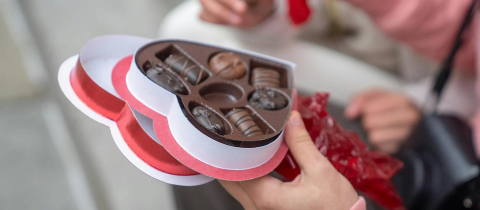Dark chocolate contains plenty of naturally occurring antioxidants known as polyphenols, which are absent from white chocolate. Actually, “white chocolate” isn’t really chocolate because it does not contain the cacao bean particles that are responsible for the characteristic taste of chocolate. All chocolate originates from cacao beans, which are found inside the fruit of the cacao tree. The beans are removed together with the pulp that surrounds them and are piled for a few days to allow fermentation to occur. During this process, yeasts and bacteria that are naturally present in the beans convert sugars to alcohol and acetic acid, which in turn initiate reactions that produce flavourful compounds. After drying, the beans are roasted, and the heat triggers yet more reactions that produce the complex molecules that together constitute the taste of chocolate. The roasted beans are then ground to produce a thick slurry known as chocolate liquor, which when pressed is separated into cocoa cake and cocoa butter. Pulverized cocoa cake gives us cocoa powder, which is used to make the cocoa we drink.
Eating chocolate is made by combining the chocolate liquor with various amounts of cocoa butter, sugar, milk solids and often vanilla for flavouring. Lecithin is commonly added as an emulsifier to prevent the separation of the cocoa fat. White “chocolate” is a concoction of cocoa butter, sugar and vanilla. Since it contains no chocolate liquor, it has no antioxidants that can prevent the fat from going rancid. Rancidity occurs when fats react with oxygen and break down to produce various nasty-smelling compounds like butyric acid. Fats that contain double bonds, in other words unsaturated fats, are more prone to this process. Most of the fat in chocolate is of the saturated variety, with stearic acid being dominant. That’s why even white chocolate without its protective polyphenols can last for weeks.
Saturated fats have been implicated in heart disease, but stearic acid converts to oleic acid rapidly in the body. This is the same fatty acid found in olives, and is not linked to heart disease. Furthermore, the antioxidant phenolics that account for as much as 8 percent of cocoa powder also offer health benefits. Of course, the real reason to eat chocolate is because it tastes so good. And contrary to what some may think, it is not addictive. Research has shown that “cravings” can be satisfied by imitation chocolate with no cocoa in it, while swallowing tasteless capsules that do contain chocolate leaves chocoholics in a state of frustration.
Want to comment on this article? Visit our FB Page!







